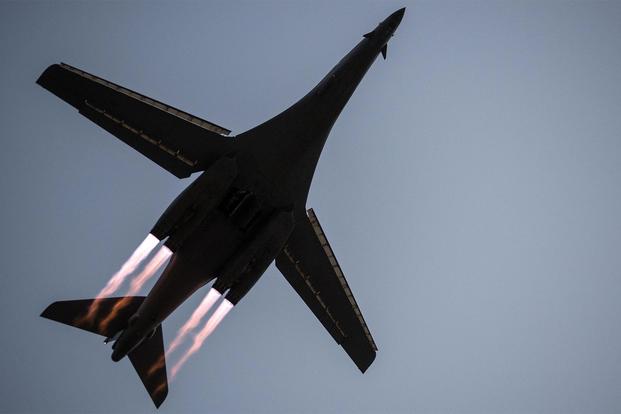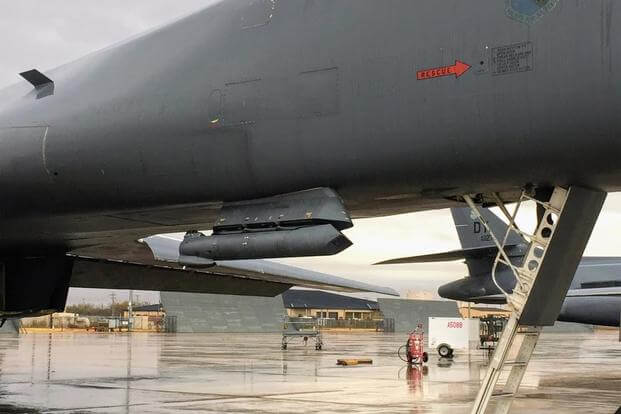DYESS AIR FORCE BASE, Texas -- B-1B Lancer pilots and crew here know questions linger within the military community after an investigation concluded a ground team and aircrew were to blame in a 2014 friendly fire incident in which five U.S. soldiers died in Afghanistan.
A B-1 on station, responding to the team under fire from the Taliban, dropped two 500-pound bombs overtop of five U.S. soldiers and one Afghan soldier in the vicinity of Arghandab on June 9, 2014. The soldiers, including two Green Berets, died in the accident.
The investigation, headed by then-Maj. Gen. Jeffrey Harrigian, deputy director of operations for U.S. Central Command, found that the Joint Terminal Attack Controller (JTAC) and ground force commander mixed up the friendly troops' and enemy fighters' locations. Harrigian is now a lieutenant general and the Air Forces Central Command commander.
But a recent "60 Minutes" report again raised questions of whether equipment onboard the B-1 was the real culprit: the Sniper Pod, which cannot detect the infrared strobes, or "marking devices," that the troops below had turned on.
Related content:
- What's on a B-1B Lancer Aircrew's Wish List? Room for More Bombs
- Anatomy of a B-1 Bomber Training Mission
- B-1 Crews Prep for Anti-Surface Warfare in Latest LRASM Tests
"The issue is not unique to the B-1 -- the issue is part of the targeting pod system and, frankly, just how electro optical systems work," said Lt. Col. Christopher Wachter, who noted he doesn't believe that recent news stories about the June TK incident have been accurately reported.
Wachter is director of operations for the 345th Bomb Squadron here. The incident, he said, happened a week before he became the deputy commander of the 379th Expeditionary Operations Group at Al Udeid Air Base, Qatar.
"This instance all revolved around a situation where very small, infrared flashing lights on helmets were not seen by an aircraft up at 25,000 feet," he said during a roundtable interview with officials here on Dec. 18.
The Sniper Pod -- fitted onto aircraft such as the B-1, F-16 Fighting Falcon and F-15E Strike Eagle -- provides improved long-range target detection and identification with high-resolution imagery for non-traditional intelligence, surveillance and reconnaissance, according to the Air Force.
Some of its features include mid-wave forward-looking infrared (FLIR), dual-mode laser, HDTV quality video, laser spot tracker, laser marker, video data link and a digital data recorder.
Military.com saw the Sniper Pod in action during a Dec. 19 training flight at the installation.
Maj. Charles "Astro" Kilchrist, chief of training for the 9th Bomb Squadron, followed a truck in the New Mexico desert to show how clear and crisp the target looked from only a few miles away.
Kilchrist noted, however, that no matter how much detail the Sniper Pod gives -- a person, for example, could be seen from seven miles away, a vehicle 10 to 15 miles away -- B-1 crews always verify that coordinates match up.
"If the JTAC on the ground tells us it's a [colorful] house, we can't see [that]," said Kilchrist, also a B-1 pilot. "He's got to do better than that. But if he says it has a fence, a roof, and two cars -- while all the houses around it have one car --- in the driveway and it matches our coordinates, we can see that. And we go with that. And we verify over and over to make sure."
The offensive weapons systems officer runs the pod. During Military.com's flight, that was Lt. Col. Erick Lord, also the 9th Bomb Squadron commander.
The pod can pick up some things on its infrared spectrum, Lord said, adding that "it depends on the wavelength." But he wouldn't specify what could be seen, or how clearly or faintly it could be picked up by the pod's sensors.
It also helps, Lord said, if there's no thermal crossover for the pod to seek out targets.
The device sometimes "picks up the sun" in the early morning or in the early evening -- but not dusk or dawn, he said during the flight. He didn't go into further detail.
The B-1 community believes the 2014 incident cannot be blamed on the Sniper Pod.
"Yes, the B-1 can't do it [see IR strobes] because of the pod, but anybody else who has that pod has the same [limiting factors] that we do," said Lt. Col. Dominic "Beaver" Ross, director of operations for the 337th Test and Evaluations Squadron.
"It wasn't B-1 specific. If it was an A-10, or an F-15 or F-16 in that situation, they would have had the same issue. I think it was just a misconception," he said.
Training between JTACs and aircrew was improved to avoid a similar mishap in the future, officials here at the base said.
To date, there is no one aircraft system, pod or sensor that can see strobes on all types of the infrared spectrum.
"The Sniper Pod can detect IR emission, but at a higher wavelength than what is emitted by the ground force IR strobes," an Air Force JTAC told Military.com on background, echoing Lord's comments.
"Just not this particular IR strobe because of its emission strength," the JTAC said during a telephone interview Wednesday.
The IR strobes the troops employed during the 2014 incident were more often used for inner teaming, or for teams to identify one another at close range, he said.
"When we start talking about targeting pods that we put on aircraft, there's quite a few of them out there. Sniper is one of the more capable. But there's certain ranges in which it can see things," the JTAC said.
Night-vision goggles, for example, assist in seeing the marking devices. But during the 2014 mission, there were limitations there, as well.
"You had B-1 pilots who had [night-vision goggles]; however, in the orbit that they were flying, they were not close enough to visually see [them] ...on the ground," the JTAC said.
"The ground party and the aircraft gave each other false positives on things they couldn't see," the controller said.
In the wake of the incident, "Air Combat Command expedited upgrades to improve B-1 sensor fusion with the Sniper Pod, weapons systems and moving map, specifically the Avionics Control Unit (ACU) data feed and the Sniper Pod Operational Flight Program (OFP) upgrades," Air Force spokeswoman Ann Stefanek told Military.com on Monday.
Its manufacturer, Lockheed Martin Corp., recently told Military.com, "Lockheed Martin continuously updates the Sniper Advanced Targeting Pod (ATP) to provide additional capability to the warfighter per the U.S. Air Force requirements."
Lockheed spokeswoman Maureen Schumann said, "To date, Sniper ATP has and continues to perform as designed."
Stefanek added, "There are no upgrades related to this issue [infrared strobes] planned for the Sniper Pod at this time."
-- Oriana Pawlyk can be reached at oriana.pawlyk@military.com. Follow her on Twitter at @Oriana0214.













